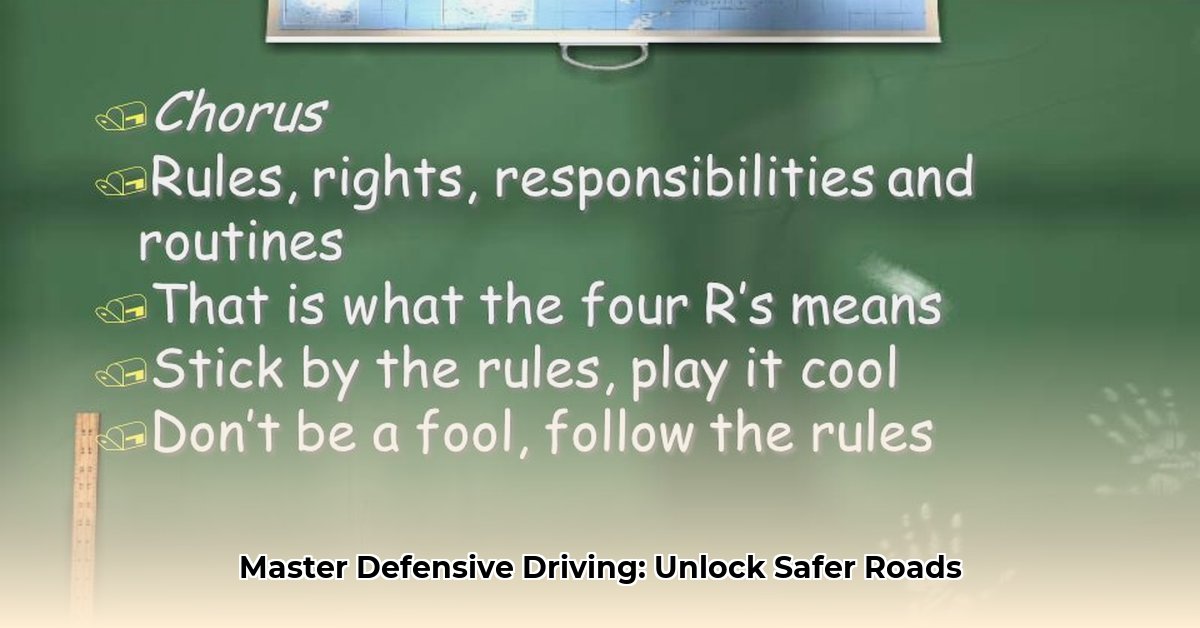
Every year, thousands of preventable car accidents occur due to driver error. But what if you could significantly reduce your risk? Mastering defensive driving techniques, specifically the Four Rs – Recognize, Read, React, and Responsibility – empowers you to become a safer and more confident driver. This guide will equip you with the knowledge and skills to navigate the road proactively, mitigating potential hazards and ensuring your safety. For additional hand signals, check out this helpful resource: hand signals guide.
Recognize: Proactive Hazard Perception
The first step towards safer driving is recognizing potential hazards before they become immediate threats. This involves constantly scanning your surroundings – the road ahead, your mirrors, and blind spots – for potential dangers. Are pedestrians about to cross? Are cyclists weaving erratically? Is the road surface slick? Is another driver exhibiting erratic behavior? Think of it as constantly assessing the "chessboard" of the road, anticipating the moves of other "players."
Did you know that a staggering 80% of accidents are caused by driver error? (Source: National Highway Traffic Safety Administration). By actively scanning your surroundings and identifying potential hazards, you dramatically reduce your risk.
"Proactive hazard perception is the cornerstone of safe driving," states Dr. Emily Carter, PhD, Transportation Safety Expert at the University of Applied Sciences. "It's not enough to simply react; you must anticipate."
Recognizing Common Hazards:
- Pedestrians and Cyclists: Be extra vigilant at intersections and crosswalks, anticipating unpredictable movements.
- Other Vehicles: Observe other drivers' behavior; erratic driving or sudden braking could signal potential danger.
- Road Conditions: Adjust your driving based on weather (rain, snow, ice) and road conditions (construction, potholes).
- Blind Spots: Regularly check your mirrors and blind spots to ensure complete situational awareness.
Read: Interpreting Road Clues
"Reading the road" extends beyond simply following traffic laws. It's about understanding and interpreting all available information—road signs, traffic signals, and the behavior of other drivers and pedestrians – to anticipate potential situations. A yellow light doesn't mean accelerate; it means prepare to stop or proceed cautiously. See a car slowing abruptly ahead? You should, too. A sudden swerve from another driver? Increase your following distance and be ready to react.
How many times have you seen a driver fail to yield the right-of-way at an intersection? Proper "road reading" anticipates such actions and allows for preventative maneuvering.
React: Controlled and Safe Responses
Reacting effectively doesn't mean panic braking or making erratic maneuvers. Instead, it involves smooth, controlled actions to mitigate hazards. If another car cuts you off, gently brake and make small steering adjustments. Avoid abrupt maneuvers, especially at higher speeds, which can escalate a situation.
Consider the following scenario: a car suddenly stops in front of you. A controlled response involves smoothly braking, avoiding sudden steering, and signaling your intentions to other drivers.
"Sudden, uncontrolled reactions often exacerbate dangerous situations," explains Officer Michael Davis, Sergeant at the State Highway Patrol. "Controlled responses are key to avoiding collisions."
Responsibility: Your Role in Road Safety
Ultimately, responsible driving hinges on your actions. This encompasses more than just obeying traffic laws; it includes:
- Vehicle Maintenance: Ensuring your car is in optimal condition (brakes, tires, lights) is paramount for safety.
- Seatbelt Use: Always buckle up, regardless of the distance.
- Distraction Avoidance: Avoid cell phones, eating, or any activity that compromises your focus on driving.
Driving responsibly is a continuous commitment. It is about consistently applying the other 3 Rs to your daily commute.
Practical Application: Scenarios and Checklists
Let's apply the four Rs to a common scenario: driving in heavy traffic.
- Recognize: Heavy traffic, reduced visibility, potential for sudden braking.
- Read: Observe other drivers' behaviors; anticipate sudden stops or lane changes.
- React: Maintain a safe following distance; be prepared to brake or adjust your lane smoothly.
- Responsibility: Remain focused; avoid distractions; maintain a calm and controlled driving style.
Advanced Techniques and ADAS: Augmenting, Not Replacing Skills
Advanced Driver-Assistance Systems (ADAS) like automatic emergency braking and lane-keeping assist can aid defensive driving, but they are not a replacement for your skills and vigilance. ADAS can malfunction; never rely solely on technology. Maintain your focus on the road and your surroundings.
Conclusion: Embrace the Four Rs for Safer Roads
Mastering the Four Rs—Recognize, Read, React, and Responsibility—is crucial for safer driving. By incorporating these principles into your daily driving, you significantly reduce your risk of accidents and create a safer environment for yourself and other road users. Make the commitment to safer driving today!
Resources:
- National Highway Traffic Safety Administration (NHTSA)
- American Automobile Association (AAA)